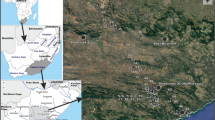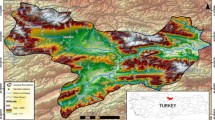Abstract
Aquatic biota in Central Asia witnesses and faces a changing environment. Because ostracodes contribute to both extant and fossil lacustrine diversity, they can be used to track evolution in water quality. Living ostracode communities in a variety of aquatic habitats of western Mongolia were analyzed in relation to environmental and hydrochemical variables of those habitats, based on presence/absence data from net samples. The sampled water bodies represent broad gradients in ionic concentration and composition. Ostracode community composition of springs differed from all other sampled habitats, which was also reflected in CCA analyses. Our data indicated that the ostracode fauna of western Mongolia shows a high response to calcium content, alkalinity, salinity, temperature, nutrients, and altitude. Species composition and diversity seem to be determined by solute evolution dominated by Ca-depletion. In general, this seems to be an important regulator of lacustrine ostracode species composition in several semi-arid regions. Binary logistic regression was used to predict the occurrence of the most common species with a minimal set of environmental variables. The resulting models showed on average low performance, and mainly demonstrated the potential of such modeling to predict the distribution of typical bio-indicator species.







Similar content being viewed by others
References
Batima, P., 2006. Climate change vulnerability and adaptation in the livestock sector of Mongolia: AIACC project report AS06. International START Secretariat, Washington.
Batkhishig, O., 2000. Influence of overgrazing for the soils cover in Mongolia. Berliner Geowissenschaftliche Abhandlungen (A) 205: 26–31.
Bouchard, R. W. & L. C. Ferrington, 2008. Identification Guide and Key to Chironomid Pupal Exuviae in Mongolian Lakes. Department of Entomology, University of Minnesota, Minneapolis: 72 pp.
Bronshtein, Z. S., 1947. Freshwater Ostracoda—Fauna of the USSR. Zoologicheskiy Institut Akademii Nauk SSSR, no 31, 339 pp. (English translation: 1988 Freshwater Ostracoda. Oconian Press, New Delhi).
Bunbury, J. & K. Gajewski, 2005. Quantitative analysis of freshwater ostracode assemblages in southwestern Yukon Territory, Canada. Hydrobiologia 545: 117–128.
Clarke, K. L., 1993. Non-parametric multivariate analyses of community structure. Australian Journal of Ecology 18: 117–143.
Coudun, C. & J.-C. Gégout, 2006. The derivation of species response curves with Gaussian logistic regression is sensitive to sampling intensity and curve characteristics. Ecological Modeling 199: 164–175.
Daday, E., 1901. Mikroskopische Suesswasserthiere. Dritte Asiatische Forschungreise des Grafen Eugen Zichy 2: 375–470.
Danielopol, D. L., 1991. Spatial distribution and dispersal of interstitial Crustacea in alluvial sediments of a backwater of the Danube at Vienna. Stygologia 6: 97–110.
De Deckker, P., 2002. Ostracod paleoecology. Geophysical Monograph 131: 121–134.
De Deckker, P. & R. M. Forester, 1988. The use of ostracods to reconstruct continental palaeoenvironmental records. In De Deckker, P., J.-P. Colin & J.-P. Peypouquet (eds), Ostracoda in the Earth Sciences. Elsevier, Amsterdam: 175–199.
Eugster, H. P. & B. F. Jones, 1979. Behaviour of major solutes during closed-basin brine evolution. American Journal of Science 279: 609–631.
Forester, R. M., 1983. Relationship of two lacustrine ostracode species to solute composition and salinity: implications for paleohydrochemistry. Geology 11: 435–438.
Forester, R. M., 1991. Ostracode assemblages from springs in the western United States: implications for paleohydrology. Memoirs of the Entomological Society of Canada 155: 181–201.
Forester, R. M., A. J. Smith, D. F. Palmer & B. B. Curry, 2005. North American Non-Marine Ostracode Database “NANODe” Version 1. Kent State University: Kent, Ohio, USA [available on internet at http://www.kent.edu/NANODe]
Fritz, S. C., 1996. Paleolimnological records of climatic change in North America. Limnology and Oceanography 41: 882–889.
Geiger, W., M. Otero & V. Rossi, 1998. Clonal ecological diversity. In Martens, K. (ed.), Sex and Parthenogenesis: Evolutionary Ecology of Reproductive Modes in Non-Marine Ostracods. Backhuys Publishers, Leiden: 243–256.
Hardie, L. A. & H. P. Eugster, 1970. The evolution of closed-basin brines. Mineralological Society of America Special Publications 3: 273–290.
Hartmann, G., 1964. Asiatischen ostracoden, systematische und zoogeographische untersuchungen. Internationale Revue der Gesamten Hydrobiologie, Systematische Beihefte 3: 1–155.
Horne, J. H., 2007. A mutual temperature range method for quaternary paleoclimatic analysis using European nonmarine Ostracoda. Quaternary Science Reviews 26: 1398–1415.
Ito, E. & R. M. Forester, 2009. Changes in continental ostracode shell chemistry; uncertainty of cause. Hydrobiologia 620: 1–15.
Ito, E., P. De Deckker & S. M. Eggins, 2003. Ostracodes and their shell chemistry: implications for paleohydrologic and paleoclimatologic applications. In Park, L. E. & A. J. Smith (eds), Bridging the Gap: Trends in the Ostracode Biological and Geological Sciences. The Paleontological Society Papers., Vol. 9. Yale University Press, New Haven: 119–151.
Järvekülg, A., 1960. Ilyodromus estonicus n. sp., eine neue süsswasser-ostracode aus Estland. Eesti Nsv Teaduste Akadeemia - Toimetised Bioloogiline Seeria 9: 27–34.
Karan-Žnidaršič, T. & B. Petrov, 2007. Non-marine Ostracoda (Crustacea) of Banat district in Serbia. Hydrobiologia 585: 57–66.
Kiss, A., 2007. Factors affecting spatial and temporal distribution of Ostracoda assemblages in different macrophyte habitats of a shallow lake (Lake Fehér, Hungary). Hydrobiologia 585: 89–98.
Manel, S., C. Williams & S. J. Ormerod, 2001. Evaluating presence-absence in ecology: the need to account for prevalence. Journal of Applied Ecology 38: 921–931.
Martens, K., S. S. Schwartz, C. Meisch & L. Blaustein, 2002. Non-marine Ostracoda (Crustacea) of Mount Carmel (Israel), with taxonomic notes on Eucypridinae and circum-mediterranean Heterocypris. Israel Journal of Zoology 48: 53–70.
Martens, K., I. Schön, C. Meisch & D. J. Horne, 2008. Global biodiversity of non-marine Ostracoda (Crustacea). Hydrobiologia 595: 185–193.
Meisch, C. 2000. Freshwater Ostracoda of Western and Central Europe. Süsswasserfauna von Mitteleuropa 8/3. Spektrum Akademischer Verlag, Heidelberg: 522 pp.
Mezquita, F., J. R. Roca & G. Wansard, 1999a. Moulting, survival and calcification: the effects of temperature and water chemistry on an ostracod crustacean (Herpetocypris intermedia) under experimental conditions. Archiv für Hydrobiologie 146: 219–238.
Mezquita, F., G. Tapia & J. R. Roca, 1999b. Ostracoda from springs on the eastern Iberian Peninsula: ecology, biogeography and palaeolimnological implications. Palaeogeography, Palaeoclimatology, Palaeoecology 148: 65–85.
Mezquita, F., H. I. Griffiths, M. I. Domínguez & M. A. Lozano-Quilis, 2001. Ostracoda (Crustacea) as ecological indicators: a case study from Iberian Mediterranean brooks. Archiv für Hydrobiologie 150: 545–560.
Mezquita, F., J. R. Roca, J. M. Reed & G. Wansard, 2005. Quantifying species-environment relationships in non-marine Ostracoda for ecological and palaeoecological studies: examples using Iberian data. Palaeogeography, Palaeoclimatology, Palaeoecology 225: 93–117.
Mischke, S., U. Herzschuh, G. Massmann & C. Zhang, 2007. An ostracod-conductivity transfer function for Tibetan lakes. Journal of Paleolimnology 38: 509–524.
Mourguiart, Ph. & P. Carbonel, 1994. A quantitative method of palaeolake-level reconstruction using ostracod assemblages: an example from the Bolivian Altiplano. Hydrobiologia 288: 183–193.
Muller, B. J., A. J. Smith, D. Palmer, E. Ito & R. M., Forester, 2002. Assessing the value of presence/absence data for ostracode-based paleoenvironmental reconstructions. American Geophysical Union abstract GS41A-08.
Neufeld, D. S. & J. N. Cameron, 1993. Transepithelial movement of calcium on Crustaceans. Journal of Experimental Biology 184: 1–16.
Park, L. E., A. S. Cohen, K. Martens & R. Bralec, 2003. The impact of taphonomic processes on interpreting paleoecological changes in large lake ecosystems: ostracodes in Lakes Tanganyika and Malawi. Journal of Paleolimnology 30: 127–138.
Peeters, E. T. H. M. & J. J. P. Gardeniers, 1998. Logistic regression as a tool for defining habitat requirements of two common gammarids. Freshwater Biology 39: 605–615.
Roca, J. R. & D. L. Danielopol, 1991. Exploration of interstitial habitats by the phytophilous Ostracod Cypridopsis vidua (O.F. Müller): experimental evidence. Annales de Limnologie 27: 243–252.
Roca, J. R., A. Baltanas & F. Uiblein, 1993. Adaptive response in Cypridopsis vidua (Crustacea: Ostracoda) to food and shelter offered by a macrophyte (Chara fragilis). Hydrobiologia 262: 127–131.
Rosenfeld, A. & R. Ortal, 1983. Ostracodes as indicators of water pollution in Nahal Harod, Northern Israel. In Maddocks, R. F. (ed.), Applications of Ostracoda. University of Houston, Houston: 229–237.
Sars, G. O., 1908. On the crustacean fauna of Central Asia. Part 3: Copepoda and Ostracoda. Annuaire du Musée Zoologique de l’Academie Imperial des Sciences de St-Petersbourg 8: 195–264.
Schwalb, A., S. J. Burns, G. Cusminsky, K. Kelts & V. Markgraf, 2002. Assemblage diversity and isotopic signals of modern ostracodes and host waters from Patagonia, Argentina. Palaeogeography, Palaeoclimatology, Palaeoecology 187: 323–339.
Shinneman, A. L. C., J. E. Almendinger, C. E. Umbanhowar, M. B. Edlund & N. Soninkhishig, 2009a. Paleolimnological evidence for recent eutrophication in the Valley of the Great Lakes (Mongolia). Ecosystems 12: 944–960.
Shinneman, A. L. C., M. B. Edlund, J. E. Almendinger & N. Soninkhishig, 2009b. Diatoms as indicators of water quality in Western Mongolian lakes: a 54-site calibration set. Journal of Paleolimnology 42: 373–389.
Smith, A. J., 1993a. Lacustrine ostracodes as hydrochemical indicators in lakes of the north-central United States. Journal of Paleolimnology 8: 121–134.
Smith, A. J., 1993b. Lacustrine ostracode diversity and hydrochemistry in lakes of the northern Midwest of the United States. In McKenzie, K. G., P. J. Jones (eds), Ostracoda in the Earth and Life Sciences, 11th International Symposium on Ostracoda. A. A. Balkema Publishers, Rotterdam: 493–502.
ter Braak, C. J. F., 1986. Canonical correspondence analysis: a new eigenvector method for multivariate direct gradient analysis. Ecology 67: 1167–1179.
ter Braak, C. J. F. & I. C. Prentice, 1988. A theory of gradient analysis. Advances in Ecological Research 18: 271–317.
ter Braak, C. J. F. & P. Šmilauer, 2002. CANOCO Reference Manual and CanoDraw for Windows User’s Guide: Software for Canonical Community Ordination (Version 4.5). Microcomputer Power, Ithaca NY, USA: 500 pp.
Turpen, J. B. & R. W. Angell, 1971. Aspects of molting and calcification in the ostracod Heterocypris. Biological Bulletin 140: 331–338.
Van der Meeren, T., Y. Khand & K. Martens, 2009. On recent species of Tonnacypris Diebel and Pietrzeniuk, 1975 (Crustacea, Ostracoda), with new species descriptions from Mongolia. Zootaxa 2015: 1–41.
Viehberg, F. A., 2006. Freshwater ostracod assemblages and their relationship to environmental variables in waters from northeast Germany. Hydrobiologia 571: 213–224.
Yanshin, A. L, 1989. Map of geological formations of the Mongolian People’s Republic. Academia Nauka USSR, scale 1:1 500 000.
Acknowledgments
We thank Y. Khand and S. N. Soninkhishig for invaluable support during fieldwork, and D. Verschuren, H. Eggermont and J. Vandekerkhove for suggestions on an early draft of the manuscript. We are also grateful to the two anonymous referees for valuable comments which improved the quality of the manuscript. Collection of the study material was supported by the National Science Foundation (NSF) under grants DEB-0316503 to Mark Edlund (Science Museum of Minnesota) and JEA. Any opinions, findings and conclusions or recommendations expressed in this material are those of the authors and do not necessarily reflect the views of NSF. The research is funded by a PhD grant of the Institute for the Promotion of Innovation through Science and Technology in Flanders (IWT-Vlaanderen) to the first author. This is Contribution 09-24 of the Limnological Research Center of the University of Minnesota.
Author information
Authors and Affiliations
Corresponding author
Additional information
Handling editor: J. Saros
Rights and permissions
About this article
Cite this article
Van der Meeren, T., Almendinger, J.E., Ito, E. et al. The ecology of ostracodes (Ostracoda, Crustacea) in western Mongolia. Hydrobiologia 641, 253–273 (2010). https://doi.org/10.1007/s10750-010-0089-y
Received:
Revised:
Accepted:
Published:
Issue Date:
DOI: https://doi.org/10.1007/s10750-010-0089-y




